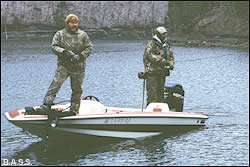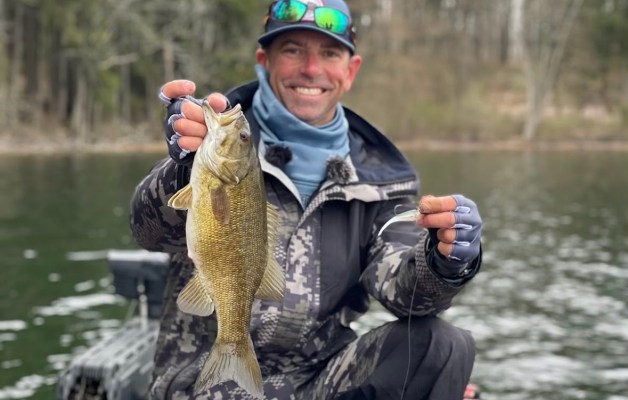
Eddie Nuckols turned to look skyward, and a sleet pellet blew up his nose!
The white stuff was peppering Tennessee's Dale Hollow Lake in a stiff angling wind. Eddie began laughing, and rubbing with his glove-covered hand, distracted momentarily from jiggling his bobber on the water's surface. When he looked back, the bobber was gone.
"Where's my float?" he blurted in a mix of surprise and panic. Then he quickly regained his composure and snapped upward with his rod. Hook sets are free. Better safe than sorry.
"Safe" might not be the right word, however, for Eddie's rod bowed, then began throbbing as an unseen, heavy fish realized it was hooked. His 4-pound-test mono was getting stretched even thinner. "Man!" was the only word Eddie could muster. He quickly started backreeling line to the fish, trying to regain control over what had started like a scene from the Keystone Cops. Finally, after several minutes of give-and-take, Nuckols guided a
4-pound "brown bass" into a net manned by his boat partner, Larry Self.
Welcome to Float-N-Fly fishing: deep-freeze days, light tackle, frequent bites and all the excitement you can stand. Eddie Nuckols usually isn't so discombobulated. Instead, he's typically all concentration and efficiency as he casts and works his small "fly." Sometimes, though, the challenges of this light tackle, down-deep fishing method cause the best anglers to come unglued.
The irony is that the Float-N-Fly technique appears so simple, almost like crappie fishing. In truth, it is intricate to a high degree and carefully refined through years of testing. The result is a presentation that just may be the best ever devised for catching cold water bass.
Make that smallmouth bass! Yes, the Float-N-Fly will take largemouth and spots that are in the neighborhood. But it's designed specifically for smallies and waters that are rarely touched by anglers using other, more standard techniques. It sprang from the deep, clear reservoirs of east Tennessee, but now the Float-N-Fly is spreading to other regions, where word is leaking out about its effectiveness.
Here's the lowdown on the Float-N-Fly — why it works, what it requires and how to do it. Anglers who copy Eddie Nuckols' methods will have little problem warming up cold days with hot fishing action.
Overview of the float-n-fly
In early winter, as water temperature drops through the 50s, bass' metabolism slows. From then until the pre-spawn, these fish feed sparingly, and they spend much of their time holding out away from shoreline in a semidormant state. Bites are usually scarce during this period for anglers who are banging the banks with jigs, spinnerbaits and crankbaits.
This is where the Float-N-Fly comes in. "This presentation targets those inactive, suspended fish," Eddie Nuckols explains. "It offers the bait in a slow, subtle manner that is very tempting to bass, even when they're not feeding. It appeals to their predatory instincts. It's little and helpless-looking, just hanging in front of them. It's too easy a target for them to pass up."
The name Float-N-Fly is an accurate description of the two main elements of this presentation. The "float" is a simple plastic bobber, about as big around as a quarter. The "fly" is a 1/8- or 1/16-ounce leadhead jig dressed with "craft hair," a synthetic fur that has a pulsing, shimmering action in the water. Float-N-Fly anglers fish this combo with extra-long spinning rods, and reels spooled with 4-pound-test monofilament. The fly is tied onto the end of the line. The float is clipped on from 9 to 11 feet above it. (When rigging, the line is actually wrapped three times around the float's spring wire hook to prevent slipping.)
When fishing the Float-N-Fly, Nuckols keeps his boat 20 to 40 yards out from the bank. (He says most fishermen casting to the bank are actually sitting right over the fish.) The long rod enables him to roll-cast his float/fly combo toward shoreline, then he waits while the fly sinks. When the weight of the jig stands the float up, Nuckols holds his rod parallel to the water, and he begins shaking the rod tip to make the bobber and fly jiggle.
He shakes the bobber/fly 10 to 12 times in quick succession, simultaneously reeling slowly to "swim" the fly toward the boat. Then he pauses for three to four seconds to allow the bait to pendulum back down.
He repeats this process until the float is almost back to the boat, then he reels up for another cast.
"This presentation makes the fly look like a dying baitfish," Nuckols explains. "Bass are attracted by its flash and struggling action. The float holds the fly in the strike zone, and it looks like an easy meal. They can just ease up under the fly, suck it in and swim away with it. When they do, they pull the float down, and this is when the fun starts!"
Float-n-fly history
Actually, the Float-N-Fly is the brainchild of Eddie Nuckols' older brother, Charlie, who was an avid bass angler and who desired to start his own lure business.
"Charlie's idea was to target winter smallmouth bass specifically," Eddie recounts. "He was a very good fisherman with jigs and blade baits, but he wanted to find a niche — some new lure and technique that nobody else had."
As youngsters, Charlie and Eddie used to fish small jigs for bass in the headwaters of east Tennessee reservoirs, where currents were strong. "We got tired of hanging up in the rocks, so we started suspending our jigs beneath floats and drifting them past ambush spots. We caught a lot of fish doing this, and this is where the idea for the Float-N-Fly came from."
Over the years, Charlie Nuckols experimented with this presentation in still, deep water. He discovered that it was deadly on suspended smallmouth. Then he began designing and producing "flies" with different color schemes. Charlie founded Bullet Lures in 1986. In the next 10 years, he built up a loyal — albeit mostly local — following of Float-N-Fly enthusiasts.
Then, tragically, Charlie Nuckols died in a boating accident in 1996. Eddie, a route driver for Federal Express, took over the operation of Bullet Lures to keep his brother's fishing legacy alive.
Since then, Eddie Nuckols has balanced his driving job with his efforts to promote the Float-N-Fly. "I tell people to take everything else out of their boat, to get rid of the temptation to lay it down, then to fish the Float-N-Fly all day long. If they'll give it a fair chance, they'll learn how effective it really is."
Nuckols and regular tourney partner Larry Self routinely show how effective the Float-N-Fly is in regional wintertime tournaments. These men — and this presentation — dominate buddy events they enter.
They have won two of the last three annual Billy Westmorland/Horse Creek Resort Invitational tournaments on Dale Hollow Lake. Whenever conditions are right and these anglers show up with their Float-N-Flies, they are odds-on favorites to win.
Float-n-fly specifics
Again, the Float-N-Fly presentation is highly refined, and anglers wishing to try it should follow Eddie Nuckols' instructions to the letter.
Running and gunning




